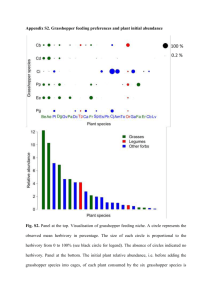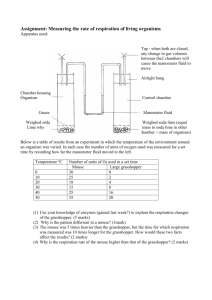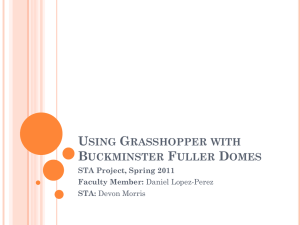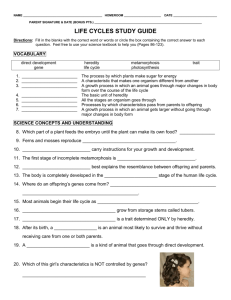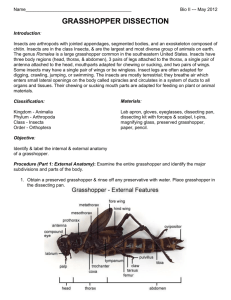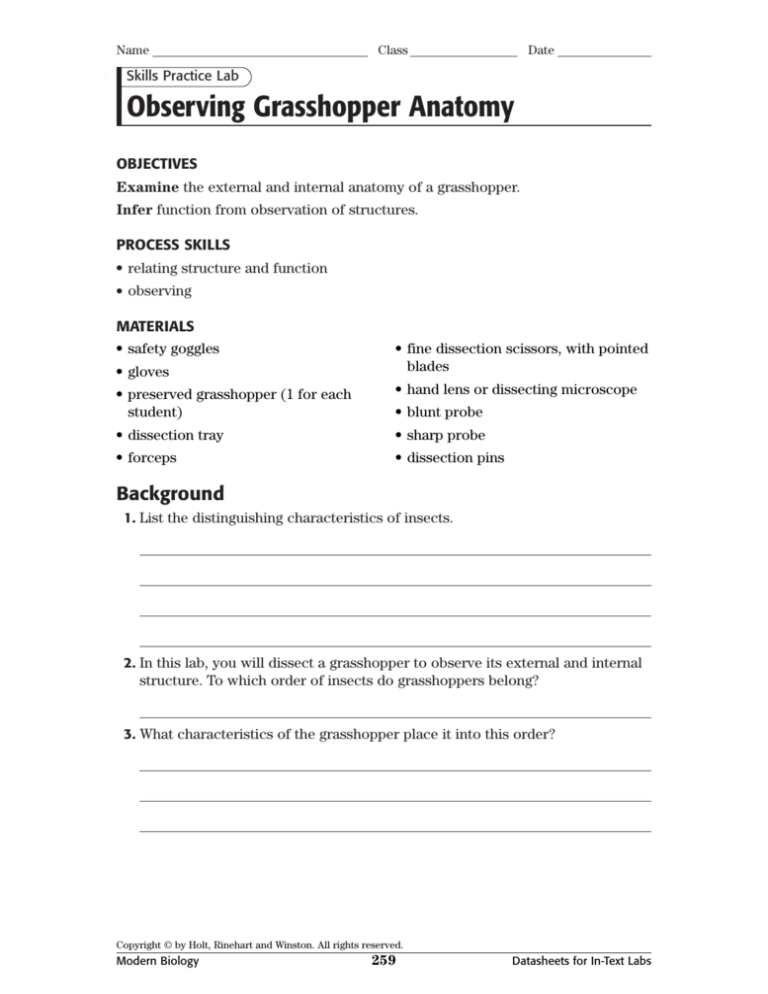
Name
Class
Date
Skills Practice Lab
Observing Grasshopper Anatomy
OBJECTIVES
Examine the external and internal anatomy of a grasshopper.
Infer function from observation of structures.
PROCESS SKILLS
• relating structure and function
• observing
MATERIALS
• safety goggles
• gloves
• preserved grasshopper (1 for each
student)
• dissection tray
• forceps
• fine dissection scissors, with pointed
blades
•
•
•
•
hand lens or dissecting microscope
blunt probe
sharp probe
dissection pins
Background
1. List the distinguishing characteristics of insects.
2. In this lab, you will dissect a grasshopper to observe its external and internal
structure. To which order of insects do grasshoppers belong?
3. What characteristics of the grasshopper place it into this order?
Copyright © by Holt, Rinehart and Winston. All rights reserved.
Modern Biology
259
Datasheets for In-Text Labs
Name
Class
Date
Observing Grasshopper Anatomy continued
PART A: OBSERVING THE EXTERNAL ANATOMY OF THE GRASSHOPPER
1.
CAUTION Wear safety goggles and gloves during this lab.
Keep your hands away from your eyes and face when working with preserved specimens. Using forceps, hold a preserved grasshopper under running water to gently but thoroughly remove excess preservative.
Then place the grasshopper in a dissection tray.
2. Use a hand lens to observe the grasshopper’s parts and refer to your textbook
to help you identify them. Identify the head, thorax, and abdomen. Note how
the thorax and abdomen are divided into segments.
3. Use forceps to spread out and examine both pairs of wings. Notice that the
forewings are narrow and the hindwings are wide. Observe how the hindwings fold fanlike against the body.
4. Observe the legs. Grasp one of each pair of legs and notice how the legs are
divided into segments. Gently bend the legs to observe their normal range of
motion.
5. Examine the 11 segments of the abdomen. On abdominal segment 1, find the
tympanum. Then, along each side of abdominal segments 1–8, locate the
spiracles, which look like small dots. Gently touch the abdomen with a blunt
probe to find the flexible membrane that connects the segments to one
another.
6. Examine the grasshopper’s head. Find the two antennae, two compound eyes,
and three simple eyes. Use a sharp probe to push apart the mouthparts.
Locate and identify the mandibles, maxillae, labium, and labrum. Note that
each maxilla has a segmented feeler called a palpus and that the labium has
two palpi.
PART B OBSERVING THE INTERNAL ANATOMY OF THE GRASSHOPPER
7.
CAUTION Dissecting instruments can cut you. Always cut in a
direction away from your face and body. Using scissors, snip off the
grasshopper’s legs, wings, and antennae at their bases. Pin the body to the
dissection tray. Then use the scissors to make a shallow cut just above the
spiracles through the exoskeleton along both sides of the thorax and
abdomen.
8. As you remove the exoskeleton, look at its underside, where the heart and
aorta may be attached. Also look for muscles attached to the inside of the
exoskeleton. Find and remove any fatty tissue (which your teacher can help
you identify) that may hide other organs.
9. If your grasshopper is a female, look for its ovaries, which may contain elongated eggs. If your grasshopper is a male, examine the ovaries and eggs in the
female grasshopper of another student. Remove the ovaries and eggs (if
present) from one side of the abdomen to uncover the digestive tract.
10. As you observe the structures listed in the table, fill in the function of each.
Copyright © by Holt, Rinehart and Winston. All rights reserved.
Modern Biology
260
Datasheets for In-Text Labs
Name
Class
Date
Observing Grasshopper Anatomy continued
11. Look for the organs of the digestive tract: esophagus, crop, gizzard, midgut,
hindgut, and anus. Find the salivary glands and the gastric ceca, which are
also parts of the digestive system.
12. On the surface of the midgut and hindgut, look for the Malpighian tubules,
which are tiny tubes that connect to the digestive tract.
13. Locate and identify the brain, ventral nerve cord, and ganglia.
14. Carefully cut away and remove the organs of the digestive system to expose
some parts of the respiratory system. Locate and identify tracheae that run
along the dorsal and ventral parts of the body, as well as other tracheae that
connect them. The larger tracheae lead to spiracles in the abdomen. Look also
for swollen tracheae, called air sacs, which increase the volume of air drawn
into the abdomen when the grasshopper breathes.
15.
Dispose of your specimen according to the directions from your
teacher. Then clean up your materials and wash your hands before
leaving the lab.
Function of Grasshopper Structures
Structure
Function
Esophagus
Crop
Gizzard
Midgut
Hindgut
Salivary glands
Gastric ceca
Malpighian tubules
Tracheae
Spiracles
Copyright © by Holt, Rinehart and Winston. All rights reserved.
Modern Biology
261
Datasheets for In-Text Labs
Name
Class
Date
Observing Grasshopper Anatomy continued
Analysis and Conclusions
1. How do you think the membrane between segments helps the grasshopper in
its movements?
2. How does the function of the stiff, leathery forewings differ from that of the
more delicate hindwings?
3. Trace the path of food through the grasshopper’s digestive tract.
4. To what system do the Malpighian tubules belong?
5. Why is the circulatory system of the grasshopper described as an open circulatory system?
6. Compared with invertebrates such as flatworms and earthworms, grasshoppers are highly responsive to environmental stimuli. What are some structural
adaptations of the grasshopper that make this responsiveness possible?
Copyright © by Holt, Rinehart and Winston. All rights reserved.
Modern Biology
262
Datasheets for In-Text Labs
Name
Class
Date
Observing Grasshopper Anatomy continued
Further Inquiry
1. Prepare an illustrated chart that compares and contrasts the characteristics of
grasshoppers, beetles (order Coleoptera), and butterflies (order Lepidoptera).
What trait of each kind of insect is reflected in the name of its order? Include
other traits in your chart.
2. The fruit fly of the genus Drosophila is an insect that, unlike the grasshopper,
undergoes complete metamorphosis. Research the life cycles of the grasshopper
and the fruit fly, and make a chart that compares and contrasts their life cycles.
Copyright © by Holt, Rinehart and Winston. All rights reserved.
Modern Biology
263
Datasheets for In-Text Labs

